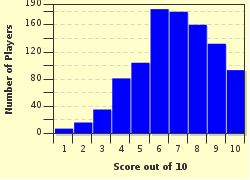Quiz Answer Key and Fun Facts
1. One of the key assessments in evaluating a patient is the Glasgow Coma Score (or Scale), which evaluates the patient's neurological status. What three things are assessed in the Glasgow Coma Score?
2. An important part of emergency medicine is having a thorough knowledge of anatomy. In which quadrant of the abdomen is the liver located?
3. Early in their careers, paramedics learn the medical use of the term "shock", as well as learning about this can best be treated. In 2008, at a basic level, how many different stages (not types) of shock were recognized and taught?
4. There are numerous causes of shock, and the paramedic needs to be aware of the causes in order to help the patient most effectively. Which of the following options can cause hypovolaemic shock?
5. Another assessment tool used by paramedics is the "Rule of Nines". For what types of injuries do paramedics apply the "Rule of Nines"?
6. Spinal cord injuries are, unfortunately, common calls for a paramedic. When questioning a conscious patient that you suspect of having a spinal cord injury, I always try to ask the patient questions that don't have a 'yes' or 'no' answer, as people often nod or shake their heads subconsciously when giving these answers. True or False - This is the preferred method of questioning a conscious patient suspected of having a spinal injury?
7. Taking a patient's blood pressure is something that happens for almost every patient a paramedic sees, and the same thing happens when you visit your doctor for a check up. One number is the systolic blood pressure, and one number is the diastolic blood pressure. What does the diastolic blood pressure represent?
8. Feeling for a pulse on any patient is something that I do almost without thinking about it these days. When I am feeling a pulse in the crook of the person's elbow, which pulse am I taking?
9. Look into my eyes is not something that is reserved for magicians and hypnotists, as paramedics look into the eyes of almost every patient (if not every patient). Pupils that are larger than normal may sometimes be referred to as 'blown'. Which of the following causes 'blown' pupils?
10. Wheezes, rales, crackles and creps (oh my!) are noises that paramedics are trained to recognise and treat during the course of their learning. In which organ do we usually refer to hearing wheezes, rales, crackles or creps?
Source: Author
ecnalubma
This quiz was reviewed by FunTrivia editor
crisw before going online.
Any errors found in FunTrivia content are routinely corrected through our feedback system.

